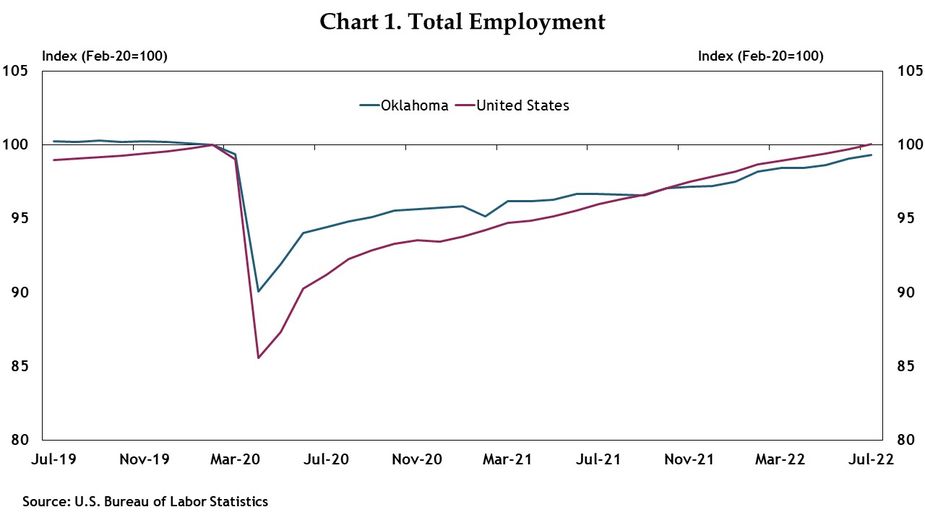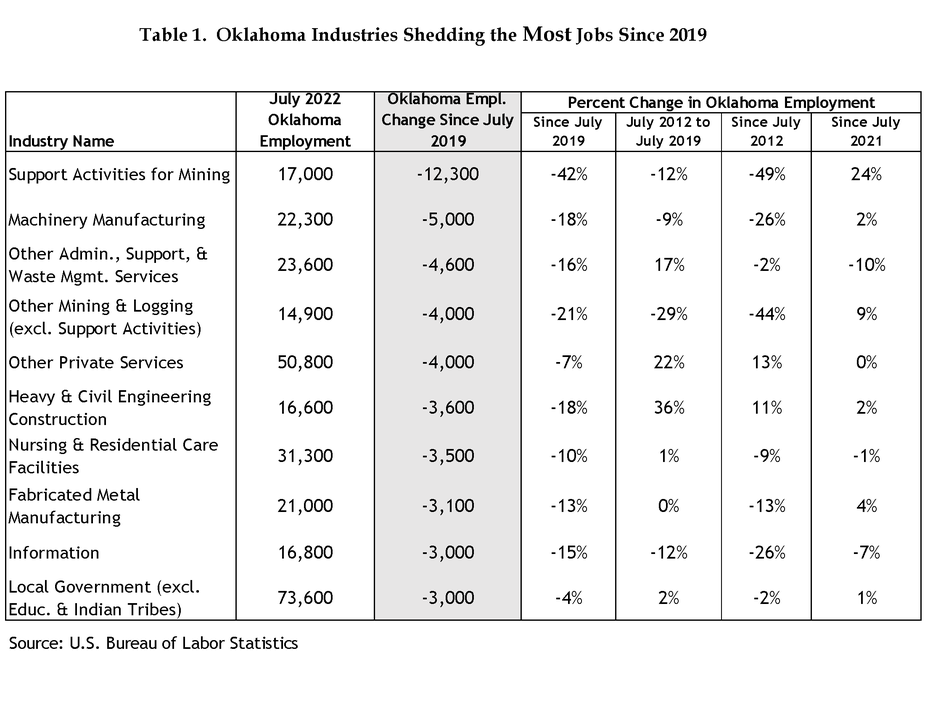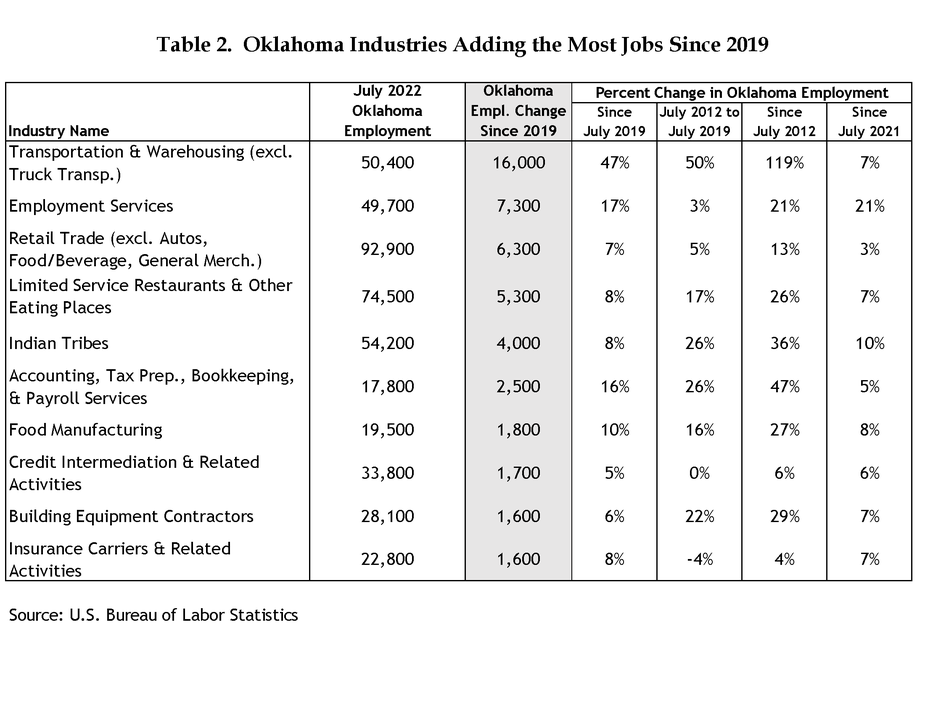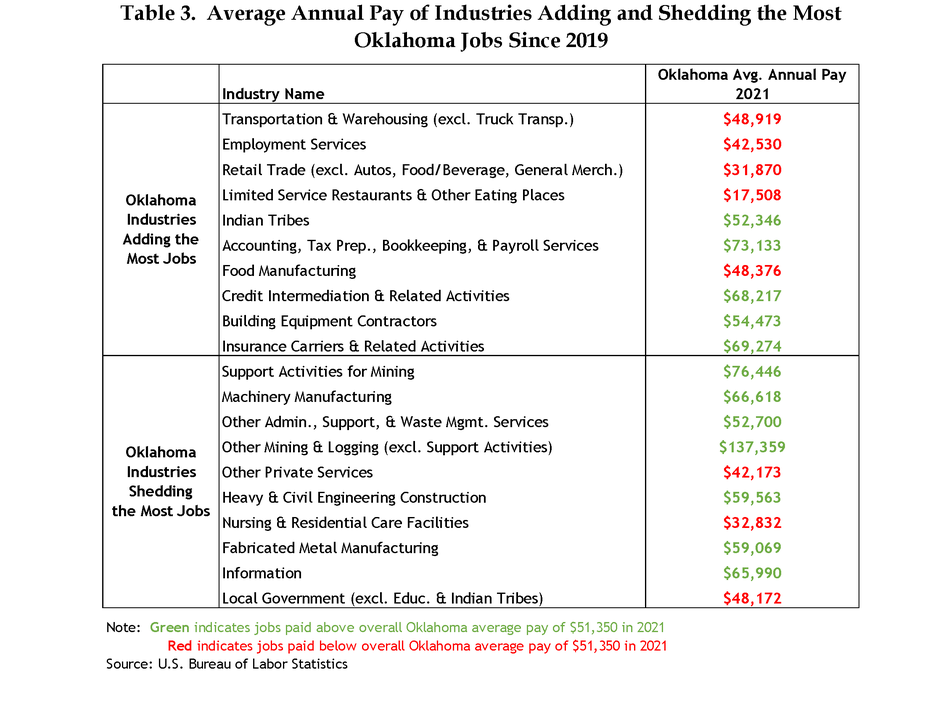Oklahoma’s Changing Employment Mix Since COVID: More Warehouse and Finance Jobs, Fewer Energy and Office Support Jobs
By summer 2022, Oklahoma’s total employment had almost returned to pre-COVID levels, after dropping 10{1b90e59fe8a6c14b55fbbae1d9373c165823754d058ebf80beecafc6dee5063a} in the spring of 2020 (Chart 1). But while nearly the same number of people are now employed in the state as in 2019, the industries in which many of them work have changed. In some sectors, employment is still more than 10{1b90e59fe8a6c14b55fbbae1d9373c165823754d058ebf80beecafc6dee5063a} below pre-pandemic levels, while jobs in other industries are up markedly from three years ago. In many cases, the changes represent a continuation—or even acceleration—of trends already underway in the previous decade. On the other hand, jobs in some industries have moved in a different direction since the pandemic. This edition of the Oklahoma Economist looks at which Oklahoma industries have added and shed the most jobs over the past three years, and how much these industries pay.

Many Shrinking Industries Tied to Energy Sector or Pandemic Trends
Up-to-date monthly employment data are available—or can be constructed based on the available data—for 52 unique Oklahoma industries that add up to total employment in the state, approximately 1.7 million workers._ As of July, ten of these Oklahoma industries had at least 3,000 fewer employees than they did three years ago (Table 1)._ In most cases, the drop represented a decline of more than 10{1b90e59fe8a6c14b55fbbae1d9373c165823754d058ebf80beecafc6dee5063a} from pre-pandemic levels.

By far the largest Oklahoma jobs decline over the past three years—in both absolute and percentage terms—was in the sub-sector Support Activities for Mining. This industry primarily encompasses oil and gas services work done on a contract basis. Other Mining sector jobs—consisting primarily of oil and gas extraction not done on a contract basis—also remain more than 20{1b90e59fe8a6c14b55fbbae1d9373c165823754d058ebf80beecafc6dee5063a} lower than in mid-2019. In both of these industries, jobs also fell considerably in the seven years prior to the pandemic, as energy sector productivity surged, oil prices collapsed in 2015, and firms failed or were consolidated. So, despite strong job gains over the past year, overall mining/energy sector employment in the state remains more than 40{1b90e59fe8a6c14b55fbbae1d9373c165823754d058ebf80beecafc6dee5063a} lower than a decade ago, a decline of nearly 28,000 jobs.
Two durable manufacturing industries linked in part to production of goods for the energy sector—Machinery, and Fabricated Metals—also still have considerably fewer jobs than prior to the pandemic, despite some growth over the past year. Jobs in both of these sectors were trending flat to down in the years prior to the pandemic.
Several industries that were growing before the onset of COVID-19 now have considerably fewer employees than in 2019. This includes Heavy and Civil Engineering Construction and Nursing and Residential Care Facilities, both of which employ about 3,500 fewer people than three years ago. Care facilities have also continued to shed jobs over the past year. This continued decline in capacity of institutions to care for the elderly and those with special needs has likely meant that many healthy working-age citizens have had to reduce their labor force participation in order to care for relatives.
Two industries that include mostly miscellaneous service industries—Other Administrative, Support, and Waste Management Services, and Other Private Services—also have considerably fewer jobs now after growing relatively rapidly from 2012 to 2019. The first sector includes subindustries such as office administrative, facilities support, and security services that have likely been impacted by fewer workers going into the office every day. Similarly, Other Private Services includes repair and maintenance, personal care services like beauty and nail salons, and dry-cleaning services that likely were also negatively affected by less commuting and office work than in the past.
Finally, jobs also remain considerably lower in the Local Government sector than prior to the pandemic, as well as in the Information sector. The Information sector includes subindustries such as publishing, broadcasting, and telecommunications that have been steadily shedding jobs for more than a decade.
Many Fast-Growing Industries Helped by Changing Consumer Preferences
By contrast, 10 Oklahoma industries have added more than 1,500 jobs since mid-2019 (Table 2). The sector with by far the largest increase—in both absolute and percentage terms—is Transportation and Warehousing, excluding truck transportation. The fastest growing subsegments of this industry, which accounted for the vast majority of growth through the end of 2021, were Warehousing and Storage, and Couriers and Messengers. Activity in these segments would include, for example, large distribution centers and transportation vehicles to deliver goods to households. This industry has grown tremendously as more people buy goods online, and it has grown even faster in Oklahoma than in the nation, especially during the pandemic. This overall industry is now over twice as large in Oklahoma as it was in 2012.

Second in job growth in the state since 2019 is Employment Services. This includes temporary worker services and employment placement services. Rapid growth in this sector has primarily occurred over just the past year, as labor markets in the state have tightened considerably, to near-record low unemployment rates. Prior to the pandemic, this sector was growing at a somewhat slower but still above average rate.
Retail Trade other than for automobiles, food/beverages, and general merchandise now has over 6,000 more jobs than in 2019. This “other retail” segment would include industries such as home improvement stores and sporting goods stores that have likely benefited from pandemic trends. It also would include retail marijuana stores under “Store retailers not specified elsewhere,” along with other retail establishments not counted otherwise._ While monthly data are not available, annual data show that this subsegment of “other retail” alone added nearly 2,400 jobs in Oklahoma from 2019 to 2021.
Limited-Service Restaurants and Other Eating Places—basically all eating places besides full-service restaurants—have also added over 5,000 jobs in Oklahoma since 2019, and strong growth has continued over the past year. The pandemic may have shifted consumers’ preferences toward less formal dining yet more eating or ordering out, although this sector was also growing rapidly in the years prior to the pandemic.
Indian Tribes added over 4,000 jobs in the past three years, with all of the net adds occurring within just the past year. So, after a brief pause in the depths of the pandemic in 2020 and 2021, this important segment of the Oklahoma economy appears to be continuing on its strong growth path of the pre-pandemic years.
Only one other Oklahoma industry has added more than 2,000 jobs since before the pandemic—Accounting, Tax Preparation, Bookkeeping, and Payroll Services. This sector has also grown rapidly at the national level and was growing solidly prior to the pandemic, in part as businesses outsource more of these services instead of conducting them in-house.
Four other Oklahoma industries added between 1,600 and 1,800 jobs from 2019 to 2022. Two of these industries—Food Manufacturing and Building Equipment Contractors—likely benefited from pandemic trends of demand for more domestic food production and increased home remodeling, but they also were growing solidly prior to 2019.
The other two fast-growing industries from 2019 to 2022 were in the finance sector—Credit Intermediation (banks and related firms) and Insurance Carriers. Both had relatively flat employment in Oklahoma from 2012 to 2019, but each have grown solidly since, including over 6{1b90e59fe8a6c14b55fbbae1d9373c165823754d058ebf80beecafc6dee5063a} in just the past year in both cases, faster than their growth in the nation as a whole.
Faster-Growing Industries Generally Have Lower Salaries
While knowing which industries are growing or shrinking fastest is useful for understanding current trends in the Oklahoma economy, it is also helpful to know how much these industries pay, relative to the 2021 average annual pay in the state of $51,350. As a whole, the fastest-growing industries in the state since 2019 pay below-average salaries, while those shrinking the most pay above-average salaries (Table 3). However, there are some key differences in both sets of industries that may provide some silver linings.

Among the 10 Oklahoma industries that have added the most jobs the past three years, the weighted average annual salary (taking into account the sizes of the sectors) in 2021 was $43,594, well below the overall state average. However, half of these industries paid above the state average, and two others—transportation and warehousing excluding truck transportation; and food manufacturing—paid only slightly below average. The inclusion of low-paying retail trade and restaurant jobs, and the larger size of these two industries, pulls the average down for the group. More positively, three of the fastest-growing industries in the state since 2019—accounting, banking, and insurance—pay over $68,000/year on average, or more than 30{1b90e59fe8a6c14b55fbbae1d9373c165823754d058ebf80beecafc6dee5063a} above the state average.
Looking at the 10 fastest-shrinking Oklahoma industries since 2019, average annual pay in 2021 was just over $56,000, well above the overall state average. Only three—local government, nursing care facilities, and other private service jobs—paid below-average wages. Of the others, energy sector jobs pay especially high wages, and average pay in the manufacturing, construction, and information industries included on the list also exceeded the state average by a sizable margin. The longer-term trend of high productivity in these industries—reflected in their higher pay—means sustainably strong job growth will likely be difficult, as fewer workers are needed to complete the same amount of work.
Summary and Conclusions
The last three years have witnessed wide swings in Oklahoma employment, both as a whole and across industries. While some Oklahoma industries have more than recovered from the pandemic—if they ever fell at all—jobs in several other industries are still markedly below pre-pandemic levels. The state’s important and high-paying energy sector, despite strong growth over the past year, remains the furthest away from pre-pandemic employment levels, as do some industries related to in-person office work. Several other higher-paying industries also continue to lag. On the other hand, a number of industries now have considerably more workers than prior to the pandemic. Warehousing and home delivery services, in particular, have grown tremendously. While a couple of lower-wage industries—specialty retail and fast-service restaurants—have experienced strong growth, some higher-paying industries have also grown rapidly, including accounting, banking, and insurance.









